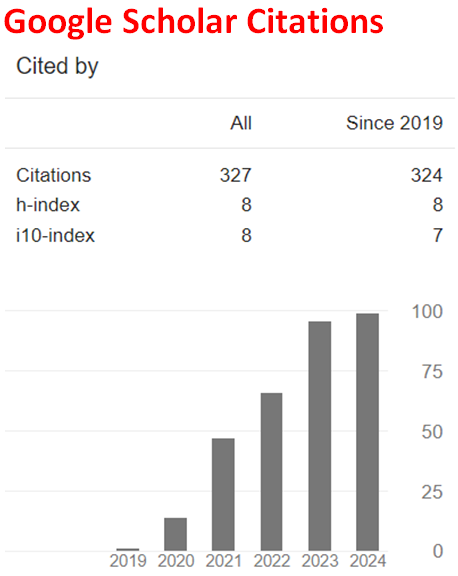Evaluation of the Use and Management Practices of Fertilizers and Pesticides by Farmers in the Municipality of Sadio (Senegal)
Abstract
To reduce losses and increase agricultural yields, farmers, in addition to fertilizers, use pesticides to achieve their objectives. With the absence of recognized commercial companies in the sale of pesticides, growers buy these products in the local market. Most of its farmers are not trained in the management and use of pesticides, so they are often the first to introduce them. To evaluate the management and utilization of its products, a survey of 50 producers indicates that more than 20 commercial specialities are registered, of which 15 names are known. The most the pesticides are emulsifiable concentrate (EC) and two are granules. This study has shown that 76% of farmers are combined chemical fertilizer and composts and 72% of them are used pesticides for the insects. Used one week by 68% growers, 41.18% of packaging and bottles are discarded in the environment after and 5.88% of containers are brought at home. Despite frequent contact with these toxic products with different symptoms, many producers are not consulted after their campaigns for a health check-up.
References
Ahouangninou, C., Fayomi, B.E., & Martin, T. (2011). Évaluation des risques sanitaires et environnementaux des pratiques phytosanitaires des producteurs maraîchers dans la commune rurale de Tori-Bossito (Sud-Bénin). Cah Agric, 20, 216-222. https://doi.org/10.1684/agr.2011.0485
Aubertot, J.N., Barbier, J.M., Carpentier, A., Gril, J.J., Guichard, L., Lucas, P., Savary, S., Savini, I., & Voltz, M. (Eds.) (2005). Pesticides, agriculture et environnement. Réduire l'utilisation des pesticides et limiter leurs impacts environnementaux. Expertise scientifique collective, synthèse du rapport, INRA et Cemagref (France), 64 p.
Charvet, R., Katouzian-Safadi, M., Colin, M.E., Marchand, P.A., & Bonmatin, J.M. (2004). Insecticides systémiques: de nouveaux risques pour les insectes pollinisateurs. Annales Pharmaceutiques Françaises, 62(1), 29-35. https://doi.org/10.1016/s0003-4509(04)94278-2
Cyperméthrine, DRC-18-157877-10983A, p.48 (n.d.). Retrieved from http://www.ineris.fr/substances/fr/
Dejoux, C. (2003). Toxicité pour la faune aquatique de quelques nouveaux insecticides: III - La deltaméthrine / III. The deltamethrine. In L. Yaméogo, C. Levêque, & J. Hougard (Eds.), Trente ans de lutte contre l’onchocercose en Afrique de l’Ouest. Traitements larvicides et protection de l’environnement: Thirty years de onchocerciasis control in West Africa. Blackfly larviciding and environmental protection (pp. 317-325). IRD Éditions. https://doi.org/10.4000/books.irdeditions.28887
Feng, J., Zhang, Q., Liu, Q., Zhu, Z., McClements, D.J., & Jafari, S.M. (2018). Application of Nanoemulsions in Formulation of Pesticides. Nanoemulsions (pp. 379-413). https://doi.org/10.1016/b978-0-12-811838-2.00012-6
Gueye, M., Seck, D., Wathelet, J. P., & Lognay, G. (2011). Lutte contre les ravageurs des stocks de céréales et de légumineuses au Sénégal et en Afrique occidentale: synthèse bibliographique. Biotechnologie, Agronomie, Société et Environnement, 15.
RAPPORT UNITAR (2005). “Guide Mauve” du SGH première édition révisée (2005) et du Document d’orientation appuyant la mise en œuvre du SGH - (IOMC-ILO-UNITAR).
Guyton, K.Z., Loomis, D., Grosse, Y., El Ghissassi, F., et al. (2015). Carcinogenicity of tetrachlorvinphos, parathion, malathion, diazinon, and glyphosate. The Lancet Oncology, 16(5), 490-491. https://doi.org/10.1016/s1470-2045(15)70134-8
Human Health Assessment Branch Department of Pesticide Regulation California Environmental Protection Agency (2018). Final Evaluation of Chlorpyrifos as a Toxic Air Contaminant. Human Health Assessment Branch of the Department of Pesticide Regulation (California Environmental Protection Agency).
INERIS (2016). Données technico-économiques sur les substances chimiques en France.
Diarra, M., et al. (2022). Identification des photoproduits de dégradation du profénofos contenu dans les eaux de rinçage des pulvérisateurs. Int. J. Biol. Chem. Sci., 16(5), 2384-2395.
Salim, M. Gasmi (2018). Neurotoxicité de deux pesticides (Acetamipride et Deltamethrine) et la prévention de cette toxicité par la quercétine chez le rat. Thèse, Université de Larbi Tebessi –Tebessa.
MINISTERE DE L'AGRICULTURE ET DE L'HYDRAULIQUE. Programme de développement des marchés agricoles du Sénégal (PDMAS). PLAN DE GESTION DES PESTES ET DES PESTICIDES. Rapport.
Mushagalusa Balasha, A., Aganze Mulume, D., Weremubi Mwisha, S., Nkulu Mwine Fyama, J., & Tshomba Kalumbu, J. (2023). Utilisation des pesticides en cultures maraîchères sur l’île d’Idjwi à l’est de la République démocratique du Congo: connaissances et pratiques des agriculteurs. Cah. Agric., 32, 5. https://doi.org/10.1051/cagri/2022033
Ntiendjui, L.G., Tamungang, S., Ferdinand, N., Ateufack, G., & Tchoumboue, J. (2009). Effets de la toxicité des pesticides Maneb et Chlorpyrifos-Ethyl sur un poisson d’eau douce, Oreochromis niloticus. International Journal of Biological and Chemical Sciences, 3. https://doi.org/10.4314/ijbcs.v3i1.42734
ONU Programme pour l’Environnement (2022). Effets des pesticides et des engrais sur l’environnement et la santé et solutions envisageables pour les réduire au minimum vers un monde sans risques chimiques.
Cissokho, P.S., Gueye, M.T., Sow, E.H., & Diarra, K. (2015). Substances inertes et plantes à effet insecticide utilisées dans la lutte contre les insectes ravageurs des céréales et légumineuses au Sénégal et en Afrique de l’Ouest. Int. J. Biol. Chem. Sci., 9(3), 1644-1653. https://doi.org/10.4314/ijbcs.v9i3.43
Yanagisawa, K., Muroi, T., Ohtsubo, T., & Watano, S. (2017). Effect of binder composition on physicochemical properties of water dispersible granules obtained through direct granulation of agrochemical suspension using fluidized bed. J Pestic Sci., 42(3), 112-115. https://doi.org/10.1584/jpestics.D17-017
Zimdahl, R.L. (2018). Herbicide Formulation. In Fundamentals of Weed Science (pp. 501-509). https://doi.org/10.1016/b978-0-12-811143-7.00017-2
Brévault, T., & Clouvel, P. (2019). Pest management: Reconciling farming practices and natural regulations. Crop Protection, 115, 1-6. https://doi.org/10.1016/j.cropro.2018.09.003

This work is licensed under a Creative Commons Attribution 4.0 International License.


